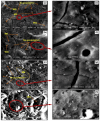Roles of Waste Glass and the Effect of Process Parameters on the Properties of Sustainable Cement and Geopolymer Concrete-A State-of-the-Art Review
- PMID: 34833234
- PMCID: PMC8624940
- DOI: 10.3390/polym13223935
Roles of Waste Glass and the Effect of Process Parameters on the Properties of Sustainable Cement and Geopolymer Concrete-A State-of-the-Art Review
Abstract
Recent research has revealed the promising potential of using waste glass (WG) as a binder or inert filler in cement and geopolymer concrete to deliver economic and environmental benefits to the construction sector. However, the outcomes obtained by different research groups are scattered and difficult to compare directly because of isolated process parameters. In this study, the roles and impacts of WG and process parameters on the performance of WG-added cement and geopolymer concrete are critically reviewed. This study reveals that the chemical and mineralogical composition, and particle size of WG, mix proportion, activation, and curing condition of concrete are the most important parameters that affect the dissolution behavior of WG and chemical reactivity between WG and other elements in concrete; consequently, these show impacts on properties of concrete and optimum WG level for various applications. These parameters are required to be optimized based on the guidelines for high pozzolanicity and less alkali-silica reactivity of WG in concrete. This review provides a critical discussion and guidelines on these parameters and the chemistry of WG in cement and geopolymer concrete for best practice and highlights the current challenges with future research directions.
Keywords: cement; concrete; geopolymer; pozzolanic reactivity; sustainability; waste glass.
Conflict of interest statement
The authors declare that they have no known competing financial interests or personal relationships that could have influenced the work reported in this paper.
Figures





























References
-
- Topçu İ.B., Canbaz M. Properties of concrete containing waste glass. Cem. Concr. Res. 2004;34:267–274. doi: 10.1016/j.cemconres.2003.07.003. - DOI
-
- Trends in Solid Waste Management: The World Bank. [(accessed on 27 October 2021)]. Available online: https://datatopics.worldbank.org/what-a-waste/trends_in_solid_waste_mana....
-
- Ferdous W., Manalo A., Siddique R., Mendis P., Zhuge Y., Wong H.S., Lokuge W., Aravinthan T., Schubel P. Recycling of landfill wastes (tyres, plastics and glass) in construction—A review on global waste generation, performance, application and future opportunities. Resour. Conserv. Recycl. 2021;173:105745. doi: 10.1016/j.resconrec.2021.105745. - DOI
-
- Guo P., Bao Y., Meng W. Review of using glass in high-performance fiber-reinforced cementitious composites. Cem. Concr. Compos. 2021;120:104032. doi: 10.1016/j.cemconcomp.2021.104032. - DOI
Publication types
LinkOut - more resources
Full Text Sources

